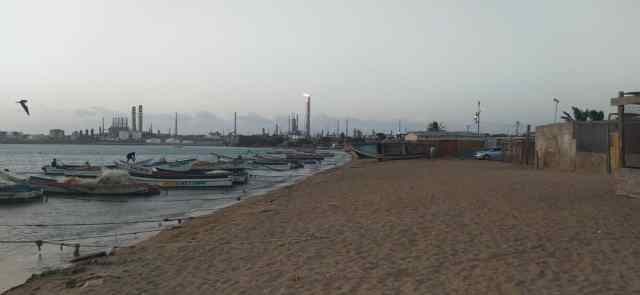
The “Golfete de Coro” continues to be battered by persistent pollution caused by oil and gas spills that cross the area to bring crude to the Amuay and Cardón refineries, which are part of the Paraguaná Refining Complex (CRP).
Correspondent lapatilla.com
This July 11th, the lapatilla.com team learned that there has been an oil leak that has for 15 continuous days at a distance of 2.5 kilometers from Río Seco going towards Punta Maragüey. The second oil spill is located 200 meters away from it and was spotted on Tuesday, July 11th, by fishermen in the area.
The third affectation is a gas leak that is 11 days old and is located 4.5 kilometers from Río Seco, also in the direction of Punta Maragüey.
It was learned from fishermen in the area that once they saw the spills, they informed PDVSA.
However, coming this Tuesday the state oil company had spent six days trying to control the most severe oil spill, which forms a long streak of oil that runs along the coastal axis of Falcón and the tide drives it towards Zulia State.
Currently, three boats with 12 divers from Pdvsa Occidente and several fishermen from Punta Cardón have been for six days clearing the area of the first oil spill to then put the clamp that would cover the hole in the pipeline.
These operations could take between 10 and 12 days, since the pipes are covered with concrete, so they have to undercut and then place the rubber seals and clamps.
Homemade clamps
Nine pipelines cross through the Golfete de Coro, of which three are inoperative, the other six are for gas, oil and drinking water pipelines. The one that frequently presents problems is the 26-inch line 2 that transports oil.
According to a reliable source, it was learned that when the oil and gas spills began in 2020, clamps imported from the United States were used, but since they ran out of their supply, which are prepared to withstand corrosion, since October last year the clamps that are being used are manufactured in PDVSA by hand and may not have a long life, because they are made of a less resistant material.
It was also known that Pdvsa deployed a boat that works only during the day to remove the remains of crude that run through the Golfete. However, overnight the spill does not stop and pollution continues.
What is the Golfete de Coro?
It is a small gulf located between the western coast of the Falconian marine coast and the Médanos de Coro isthmus, between the points of Cardón and Maragüey.
It is an important and protected area that includes Punta Maragüey, Punta Caimán and Las Tijeras islands, which are places for the conservation of migratory shorebirds and a great variety of marine species. This area is ideal for shrimp farming.
On June 24th, the president of PDVSA, Pedro Tellechea, carried out an overflight with other authorities from Falcón and a delegation of fishermen from Río Seco to assess the state of the seabed due to oil spills.
A press release from the Ministry of Petroleum states that among the first actions is the replacement of pipes 1 and 2 that cross 23 kilometers of Golfete de Coro, and line 3 with a five kilometer long submarine stretch, all of which transport crude oil to the Paraguaná Refining Complex.
In addition, Community Spill Response Brigades will be formed, with fishermen from the area who will receive training required by PDVSA’s Executive Directorate for the Environment and will be complemented by oil workers to be alert to any eventuality in this area.
The actions are framed in the “Petróleo Verde” plan, although it does not contemplate any planned sanitation or cleanup for the Golfete de Coro.

